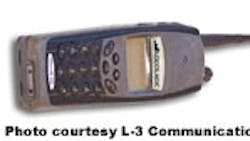Could a wireless system that sends a signal pinpointing the location of coal miners prevent future mining fatalities? Defense systems technology provider L-3 Communications Inc. has developed a wireless tracking system that it claims will modernize mine safety.
The National Institute for Occupational Safety and Health (NIOSH) selected L-3 Communications to develop a technology that would meet the Mine Improvement and New Emergency Response Act, also known as the Miner Act. President Bush signed into law the Miner Act in June 2006, just months after the Sago mine disaster in West Virginia killed 12 International Coal Group miners.
Part of the Miner Act was a requirement that by June 15, 2009 all underground coal mines submit a plan that provides for a post-accident communication system between underground personnel and surface personnel via a wireless two-way medium and an electronic tracking system. The goal was to provide surface personnel with a way to locate trapped miners more quickly.
In conjunction with Virginia Tech University and other technology partners, L-3 developed a system that consists of "mesh" networking nodes throughout the mine, sometimes thousands of feet apart, that receive information from handsets provided to the miners, says Victor Young, mine safety director for L-3 Communications. The handsets are similar to cell phones except they are more rugged. Each handset is assigned a number that uniquely identifies it with a particular miner, Young says.
L-3's Accolade wireless mesh mine safety system allows for two-way communications from mines to the surface.
Most mines today utilize a traditional pager-phone system where miners have to move to a specific location to speak with someone, whereas the L-3 system provides more mobility, says Young. "It brings mine safety into this century as far as communications and tracking," Young says.
The system, called Accolade, also helps create efficiencies in the mine by ensuring people and equipment are going to their intended locations. In addition, it can be enabled to track atmospheric conditions and equipment maintenance conditions, Young says.
L-3 has a pilot system operating in International Coal Group's Sentinel mine in West Virginia and has contracts to install systems for all 14 of Rosebud Mining Co.'s mines in western Pennsylvania and Ohio, Green River Collieries' Advent Mine in western Kentucky, and for an extension of the existing system at the Sentinel Mine.
See Also
About the Author
Jonathan Katz
Former Managing Editor
Former Managing Editor Jon Katz covered leadership and strategy, tackling subjects such as lean manufacturing leadership, strategy development and deployment, corporate culture, corporate social responsibility, and growth strategies. As well, he provided news and analysis of successful companies in the chemical and energy industries, including oil and gas, renewable and alternative.
Jon worked as an intern for IndustryWeek before serving as a reporter for The Morning Journal and then as an associate editor for Penton Media’s Supply Chain Technology News.
Jon received his bachelor’s degree in Journalism from Kent State University and is a die-hard Cleveland sports fan.
